For moon photography, you'll want to start with either the Canon EOS Rebel T8i or Nikon D5600, both offering excellent manual controls and compatibility with affordable telephoto lenses under $1000. These cameras feature strong low-light performance, RAW shooting capability, and spot metering to capture lunar details. Look for models with at least 24MP sensors and the ability to handle shutter speeds between 1/125 to 1/800 second. The right camera combined with proper technique will transform your lunar shots from bland white dots to stunning celestial portraits.
What Makes a Good Moon Photography DSLR Camera

When choosing a DSLR camera for moon photography, specific features and capabilities become vital for capturing detailed lunar images.
You'll want a camera with extensive manual controls to adjust ISO, shutter speed, and aperture precisely. While both full-frame and crop-sensor cameras work well, crop-sensor models offer an advantage by providing additional reach through their inherent crop factor.
Look for a camera that shoots in RAW format and offers spot metering capabilities to properly expose the moon's bright surface. Clear skies during Covid-19 have made moon photography more accessible than ever before.
RAW shooting and spot metering are essential camera features for achieving proper exposure when photographing the moon's luminous surface.
You'll need fast shutter speeds to counter the moon's movement, so make sure your camera can handle speeds between 1/125 to 1/800 second.
While the latest sensor technology isn't vital since the moon is bright, having a larger sensor helps capture more detail and provides better overall image quality.
Top Entry-Level DSLR Cameras Under $1000
For aspiring lunar photographers on a budget, several entry-level DSLRs offer impressive capabilities without breaking the bank. The Canon EOS Rebel T8i/850D stands out as the top choice, featuring a 24.1MP sensor and exceptional autofocus system that's perfect for capturing lunar details. Its comfortable handgrip and well-spaced controls make it easier to maintain stability during long exposure shots.
You'll find strong alternatives in the Nikon D5600, which includes a helpful Guide Mode for beginners, and the weather-sealed Pentax K-70, ideal for outdoor shooting sessions.
The Sony Alpha a68 excels with its advanced tracking capabilities, while the lightweight Canon EOS Rebel SL3 adds 4K video to its impressive feature set.
Each camera offers at least 24MP resolution, ensuring you'll capture crisp moon details. They're all compatible with various lenses and accessories, allowing you to expand your gear as your skills grow.
Essential Camera Features for Lunar Photography

Successful moon photography requires specific camera features that can make or break your lunar shots. When choosing your starter DSLR, you'll need a camera that offers full manual controls and strong low-light performance. The ability to shoot in RAW format is essential for capturing detailed moon images that you can enhance in post-processing.
Moon photography demands specialized camera features, including manual controls, low-light capability and RAW shooting for best results.
Your camera must support these fundamental capabilities:
- Manual focus mode with live view magnification for precise lunar surface focusing
- Spot metering functionality to accurately expose the moon's bright surface
- Fast shutter speeds (at least 1/125 sec) with high sync capabilities
Look for models that offer customizable buttons and dials for quick setting adjustments in the dark. Using a remote shutter release can help eliminate any camera movement during exposure.
You'll also want a camera that's compatible with telephoto lenses and remote shutter releases to minimize vibration during shooting.
Best Budget Lenses for Moon Photography
A quality lens makes all the difference in moon photography, and you don't need to spend thousands to capture stunning lunar details.
For DSLR users, the Canon EF-S 55-250mm f/4-5.6 IS STM at $300 offers excellent value with its image stabilization and sharp optics. If you're using Nikon, consider the AF-P DX NIKKOR 55-200mm VR at $200, which delivers similar capabilities.
For even more reach, the Tamron 70-300mm f/4-5.6 Di VC USD provides enhanced magnification at around $500. For optimal moon framing, you'll want to aim for a 2000mm equivalent reach through lens combinations or teleconverters.
Don't dismiss telescope options either – you can adapt your DSLR to a budget-friendly telescope like the SVBONY SV503 for impressive lunar shots.
Whatever lens you choose, guarantee it has image stabilization and a focal length of at least 200mm to capture the moon's details effectively.
Camera Settings and Techniques for Sharp Moon Shots

While capturing the moon might seem straightforward, achieving tack-sharp lunar images requires precise camera settings and proven techniques.
You'll need to master manual mode and spot metering to control exposure accurately, keeping your ISO between 100-400 for minimal noise. Using a telephoto lens range starting at 200mm will help you capture more lunar details.
- Set your shutter speed between 1/125 and 1/800 seconds to freeze the moon's motion.
- Choose an aperture of f/4 to f/11 for ideal sharpness.
- Underexpose by one stop to preserve lunar surface details.
Switch to manual focus and use live view with digital zoom for precise focusing.
Don't forget to mount your camera on a sturdy tripod and use either a remote shutter release or timer to eliminate camera shake.
For the best results, shoot in RAW format to maintain maximum flexibility during post-processing.
Must-Have Accessories for Beginner Moon Photography
Getting started with moon photography requires more than just a camera body and lens.
You'll need a sturdy tripod to eliminate camera shake and a remote shutter release or timer to minimize vibrations when taking shots. These tools are essential for capturing sharp, clear images of the moon.
While a 200mm lens will get you started, consider investing in a telephoto lens between 400-600mm for more detailed moon shots. Remember that the quality of your moon photos depends more on your shooting technique than expensive equipment.
Shooting in RAW format is vital as it gives you greater flexibility during post-processing.
To make your lunar photography sessions more productive, download a moon tracker app to help you plan your shoots based on moon phases and positions.
Don't forget protective gear like lens caps and a camera bag to safeguard your equipment from damage.
Common Moon Photography Mistakes to Avoid

Setting your camera incorrectly can ruin your moon shots, with improper exposure settings and slow shutter speeds being the most common culprits.
You'll want to avoid equipment setup mistakes like unstable tripod placement or poor focus adjustments, which often result in blurry or soft images. Using a quality telephoto lens with 200-400mm range is essential for capturing clear lunar surface details.
Poor timing choices, such as shooting without checking weather forecasts or moon phases, can leave you missing prime opportunities for capturing detailed lunar textures and crater definition.
Wrong Camera Settings
Because moon photography requires precise camera control, using incorrect settings can quickly ruin your shots.
You'll need to master exposure settings beyond auto mode, which often overexposes the moon by incorrectly assuming average scene brightness. Understanding ISO, shutter speed, and manual controls is essential for capturing the moon's details without unwanted noise or blur. Capturing during golden hour or blue can dramatically impact the moon's color and exposure settings.
Three vital camera setting mistakes to avoid:
- Relying on auto mode instead of using the Sunny 16 rule as your starting point for proper exposure
- Setting incorrect ISO values that produce either excessive noise in low light or insufficient brightness
- Using inappropriate shutter speeds that don't account for the moon's movement or camera shake
Always shoot in RAW format to preserve maximum detail and allow for exposure adjustments during post-processing.
Equipment Setup Issues
While mastering camera settings is fundamental, proper equipment setup directly impacts your moon photography success.
You'll need a sturdy tripod positioned on firm ground to prevent unwanted camera movement, especially when using telephoto lenses. Make sure your tripod's weight distribution is balanced and consider using additional weights in windy conditions.
Your lens choice matters greatly – opt for a telephoto lens with at least 200mm focal length, and enable its image stabilization feature. Preparing for special events like Supermoons and Micromoons can create extraordinary photographic opportunities.
Don't forget to use a remote shutter release or your camera's timer to minimize vibrations during exposure. If you're using an entry-level DSLR like the Canon EOS Rebel, compensate for its smaller sensor by paying extra attention to your manual focus and aperture settings (aim for f/8 to f/11) to capture sharper details.
Poor Timing Choices
Successful moon photography depends heavily on your timing choices, which can make or break the final image. Without proper planning, you'll miss vital photo opportunities and end up with flat, uninteresting shots.
Understanding natural light conditions and moon phases is essential for capturing stunning lunar photographs. Consider using apps like PhotoPills to analyze lighting conditions and plan your shots effectively.
Here's what you need to watch out for:
- Moon phases matter – shooting during a full moon reduces crater definition, while waxing and waning phases offer better detail and contrast.
- Natural light timing is significant – avoid harsh daytime shots and instead aim for golden hour, blue hour, or civil twilight for ideal lighting conditions.
- Weather patterns affect visibility – always check weather forecasts to avoid cloud cover, mist, or atmospheric distortion that can ruin your shot.
Remember to use planning tools to predict moon alignment and timing for the best results.
Professional Tips for Better Moon Images

Taking exceptional moon photographs requires more than just pointing your camera at the night sky.
You'll need a super-telephoto lens of at least 300mm and a sturdy tripod to capture clear, shake-free images. Don't forget to use a remote shutter release to minimize camera vibration.
Set your camera to manual mode with a shutter speed between 1/125 to 1/800 seconds, aperture at f/8 to f/11, and keep your ISO low at 100-400.
Use spot metering to focus on the moon's brightness and always shoot in RAW format for better editing flexibility.
Choose your timing wisely by planning around moon phases, and seek locations away from light pollution. Try photographing when the moon is near the horizon for a more dramatic prominent appearance in your shots.
Consider using ND filters to reduce glare and enhance details, especially during bright phases.
For creative shots, try incorporating landscape elements into your composition.
Recommended Learning Resources for Moon Photography
You'll find invaluable guidance through online photography communities like Reddit's r/Astrophotography and r/Photography, where experienced photographers regularly share their moon shooting techniques and feedback.
Free video tutorials on platforms like YouTube offer step-by-step instruction on camera settings, composition, and post-processing specifically for lunar photography.
These learning resources can help you master moon photography while connecting with fellow enthusiasts who share your passion for capturing Earth's celestial companion. To prepare for upcoming opportunities, mark your calendar for the total lunar eclipse on March 14, 2025, which will be visible across the Pacific, Americas, western Europe, and western Africa.
Online Photography Communities
Moon photography enthusiasts can find invaluable support and guidance through various online communities and social platforms.
Whether you're looking to share your work or learn from experienced photographers, these digital spaces offer rich opportunities for growth and networking.
- Facebook groups and Reddit forums (like r/photography) provide dedicated spaces where you'll get personalized feedback and can engage in discussions about equipment, techniques, and upcoming lunar events.
- Instagram's #MoonPhotography community connects you with fellow enthusiasts while showcasing your work to a global audience.
- Discord servers offer real-time conversations and instant feedback, making it easier to troubleshoot issues or plan shooting sessions.
For specialized learning, platforms like Flickr and 500px feature dedicated moon photography sections where you can study others' work and gain inspiration for your own shots. These communities are excellent places to learn about using manual camera settings and experiment with different techniques.
Free Video Tutorial Courses
Free video tutorials serve as an excellent starting point for aspiring lunar photographers, offering extensive guidance without the financial investment of paid courses.
You'll find detailed content on platforms like YouTube, where channels such as The School of Photography and PhotoGenius provide thorough instruction on camera settings, equipment selection, and composition techniques.
These tutorials focus on essential skills you'll need, including mastering manual mode, selecting dark shooting locations, and understanding moon phases.
Popular channels cover specific guidance for Nikon and Canon DSLRs, teaching you how to capture sharp, detailed moon images using telephoto lenses and tripods.
For advanced techniques, you can explore astrophotography tutorials that investigate using telescopes and teleconverters.
Many tutorials emphasize the importance of using a self-timer or remote to eliminate camera shake during exposure.
Remember to practice regularly and experiment with different approaches as you develop your skills.
Frequently Asked Questions
Can I Photograph the Moon During Cloudy Weather or Through Light Pollution?
Yes, you can shoot the moon in cloudy weather or through light pollution. You'll need to adjust your exposure settings, use a telephoto lens, and consider bracketing techniques to capture detailed shots successfully.
How Long Does It Typically Take to Master Basic Moon Photography?
You'll need about 3-6 months of dedicated practice to master basic moon photography. If you're shooting weekly, learning manual settings, and mastering post-processing techniques, you'll see significant improvement in your shots.
Are Mirrorless Cameras Better Than DSLRS for Photographing the Moon?
You'll find both mirrorless and DSLRs can capture great moon shots. However, mirrorless cameras offer advantages like better low-light performance, superior stabilization, and real-time exposure preview through their electronic viewfinders.
Should I Clean My Camera Sensor More Often When Shooting the Moon?
You don't need to clean your sensor more often for moon photography specifically. However, since you'll notice dust spots more easily in moon shots, it's good to maintain regular cleaning intervals.
Can Extreme Temperature Changes During Night Shoots Damage My Camera Equipment?
Yes, rapid temperature changes can harm your camera. You'll need to acclimate it gradually and keep spare batteries warm. Use a padded bag and avoid condensation by letting your gear adjust slowly between environments.
In Summary
You're now equipped with the essential knowledge to start your moon photography journey. Whether you choose the Nikon D3500, Canon Rebel T8i, or another entry-level DSLR, remember that patience and practice are key. Start with the basic gear recommendations, master the suggested camera settings, and don't forget the vital accessories. With these tools and techniques, you'll be capturing stunning lunar images in no time.
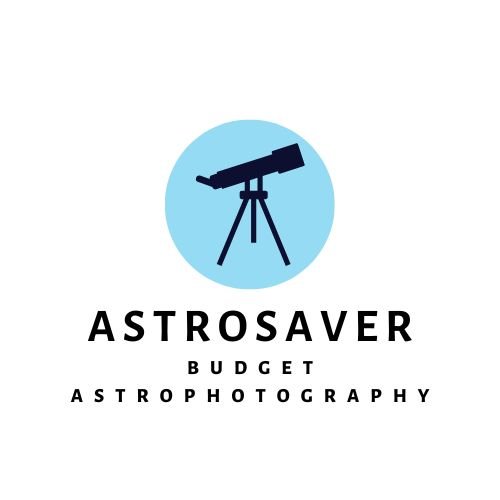
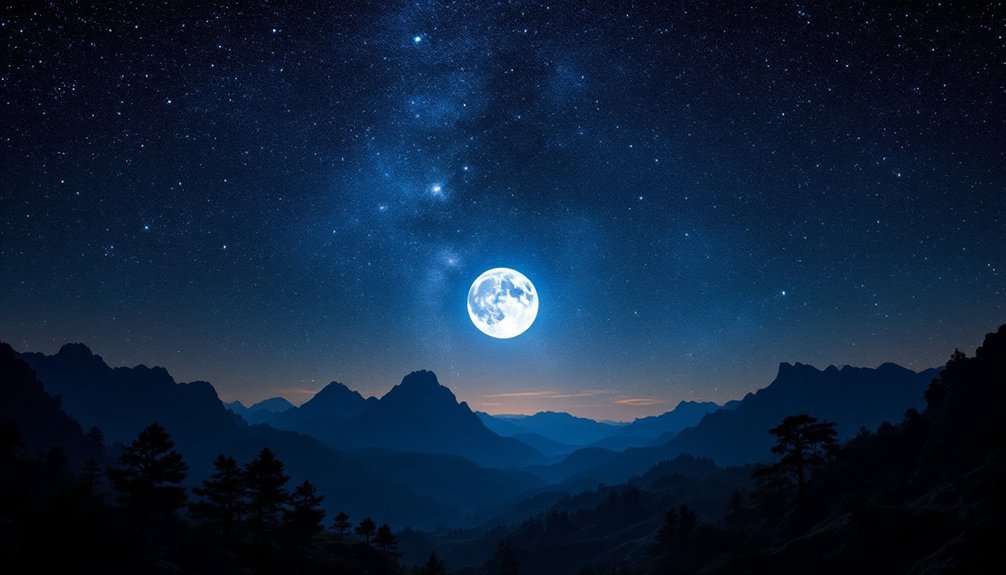
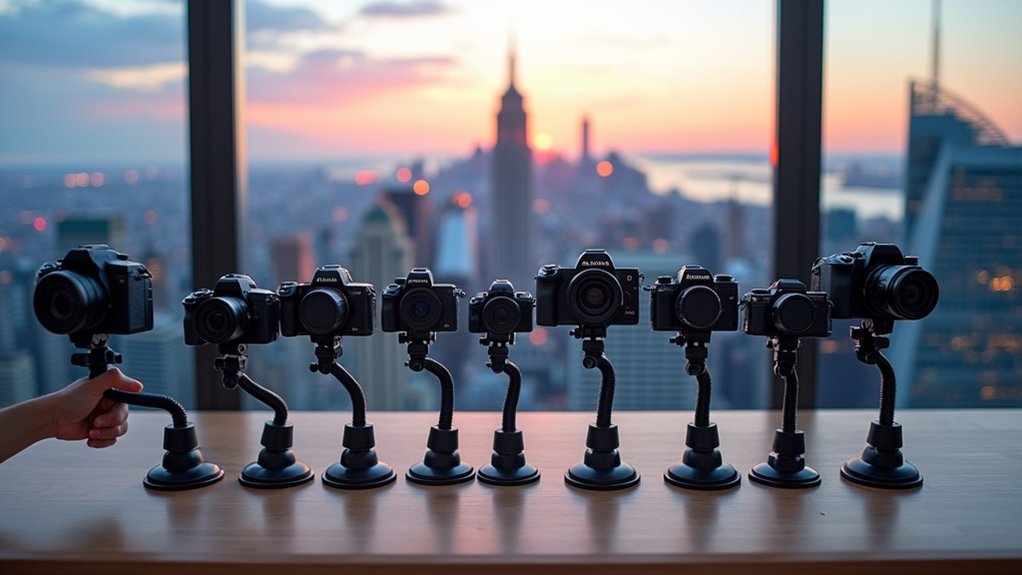
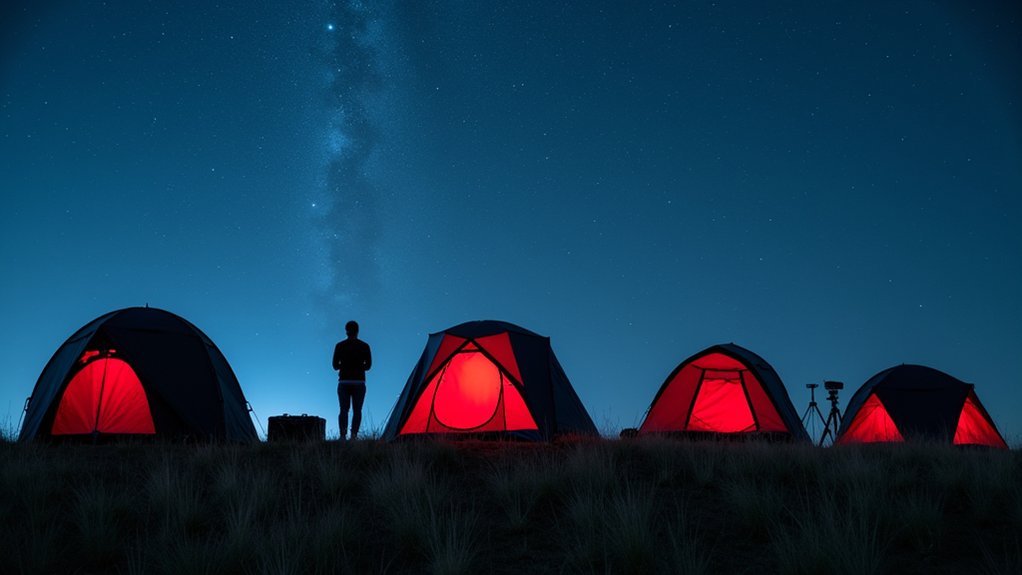
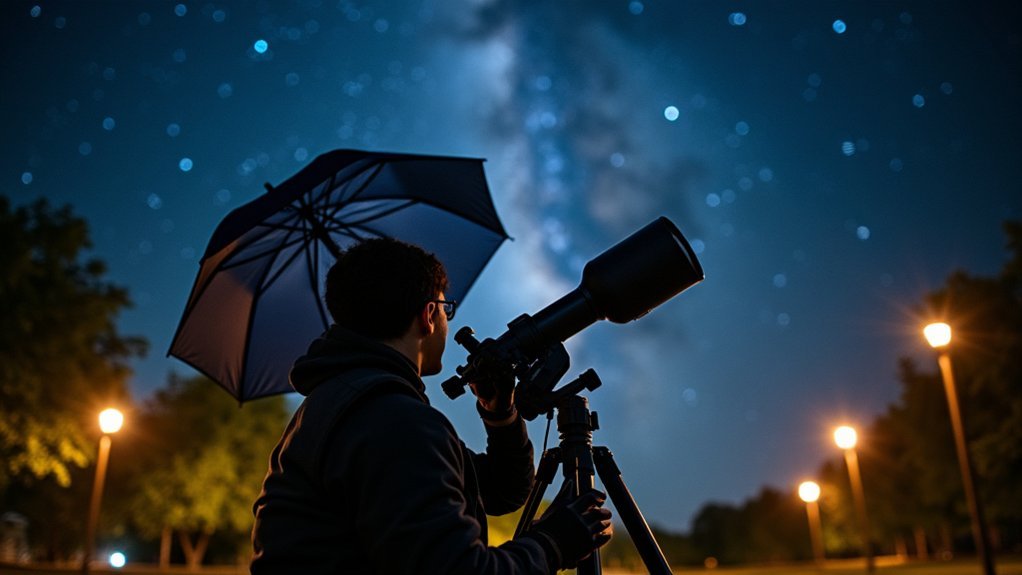
Leave a Reply